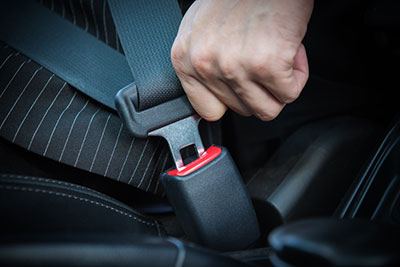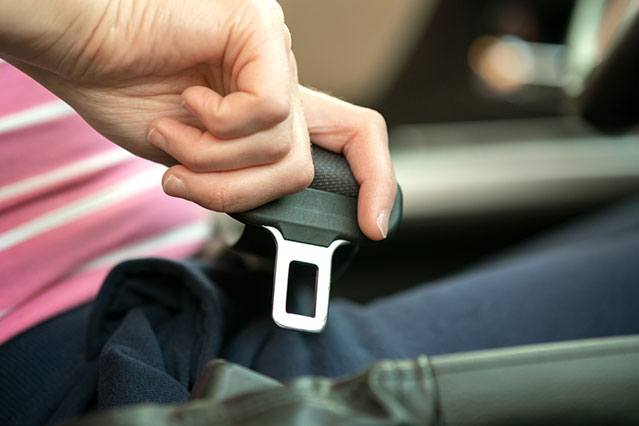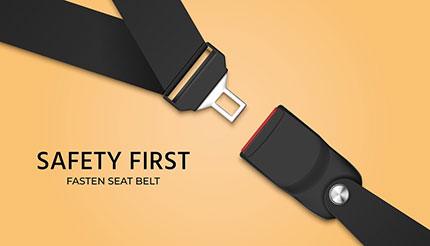Driving with your seat belt on decreases the chance of severe injuries by 50%. However, did you ever stop and wonder:
How seatbelts work so effectively?
In this guide, we will talk about seat belt safety and how the technology behind it helped save millions of lives behind the wheel.
More...
Seat Belt History in Brief
The seat belt was first created at the beginning of the 1800s. Although the initial use for the seat belt was in the aeronautical industry, the design changed over the years.
In 1946, Dr. C. Hunter Shelden created retractable seat belts to prevent car crash-related head trauma. However, it wasn't until the 1950s that Nils Bohlin designed the first three-point seat belt system.
Before the seat belt law became mandatory in the US in 1984, seat belts were considered somewhat controversial. Drivers refused to buckle up as they began to see the belt as a form of an intrusive Government matter, especially with the introduction of automatic seat belts.
However, as the mandatory seat belt law became effective in 48 states, car manufacturers implemented seat belts into every model.
Seat belts help travelers follow the same speed as the moving vehicle. In addition, seat belts save you from not being thrown out of the vehicle during a car crash. Along with airbags, seat belts are the most effective safety feature that saves millions of lives yearly.
How Does a Seat Belt Work in a Crash?

Safety Guidelines of Seat Belts
A seat belt is only effective and safe if used properly. These safety belt guidance tips will help with the proper use of the seat belt:
Parts of the Seat Belt

How to Properly Wear a Seat Belt?
The vehicle occupant must sit upright when wearing a seat belt. The seatbelt works by keeping you in a proper position without slouching forward.
The three attachment points work together to support the chest and pelvic area. The shoulder belt extends to the chest and must lie flat on the collarbone. The lap belt goes across the upper thighs, hips, and pelvic.
A seat belt can be worn with seat belt cushions for the children in the back seat using a booster. The seat belt cushions offer all pressure points comfort and ensure a good fit.
How Does a Seatbelt Mechanism Work?
The seatbelt is connected to the retractor mechanism. Inside the retractor box, the spool and spring system are vital elements. One connects the spool to the seat belt, while the attached spring applies torque or rotational force to the spool. The rotating spool works by winding up the loose webbing of the belt.
If the webbing is pulled out, the spool rotates counter-clockwise while the spring rotates in the same direction. The rotation force of the rotating spool works to untwist the spring back into its original shape. However, the spring resists the twisting motion and tightens if the webbing is released. In this state, the spool rotates clockwise until there is no more slack in the belt.
A typical seatbelt system has a locking mechanism that prevents the spool from rotating during a collision. The prevention of the rotation offers maximum safety. As we discussed above, there are two locking mechanism types.
The central element of a belt movement locking is a centrifugal clutch. The centrifugal force pushes the weighted end of the lever outward when the webbing is pulled along with the activated spool.
The basic idea of the seatbelt work is to tighten under pressure while the stopping force spreads across the body's strongest parts.

How to Fix a Tangled Seat Belt?
The most common seat belt issue is the tangling of the webbing. The entanglement occurs if the seat belt is not pulled or retracted correctly.
Fixing a tangled seat belt is to unspool the belt entirely, untangle it and retract it slowly. However, if there appears to be an obstruction of the spool, it's best to ask for professional help.
FAQs
How does a seatbelt protect you?
During a collision, a seatbelt is designed to protect and disperse the force on the strongest body parts-the pelvis and the chest. In addition, a seatbelt protects the occupant by allowing the body to match the vehicle's speed and prevent ejection in case of a crash.
How do you release a seatbelt after an accident?
To release a seatbelt after an accident, pull out the webbing along to unlock the seatbelt. The safety belt can also be removed if the retractor is pulled out completely.
Do all seatbelts lock after an accident?
During an accident, all seatbelts can lock due to the pendulum activation, which stops the seat belt mechanism.
How do seatbelts and airbags work together?
A seatbelt helps your body match the vehicle's speed, while the airbag cushions the body and protects against crash impacts. Both airbags and seatbelts are designed to work together the best in delivering optimal safety results.
If the vehicle occupants are not combining the seat belt and the airbag, they could suffer severe injuries during a crash.
Why do airbags not work without seatbelts?
Airbags help cushion the body during a collision, but without the seatbelt, the body will only collide with the airbag and spring back into the car seat. The forceful impact could lead to fatal injuries, so it's necessary to combine seatbelts and airbags.
Why are seatbelts so strong?
Seatbelts can endure forceful loads of up to 6000 lbs due to their high-tensile fiber webbing, making the seatbelt solid and durable.
Final Words
A seatbelt is a life-saving invention designed to protect the body during the drive. Although the invention of the seatbelt was controversial in its beginning stage, the population soon began to release the importance of the seatbelt.
We hope you learned how seatbelts work for the benefit of vehicle passengers. Remember to buckle up and respect road safety on your next trip!
